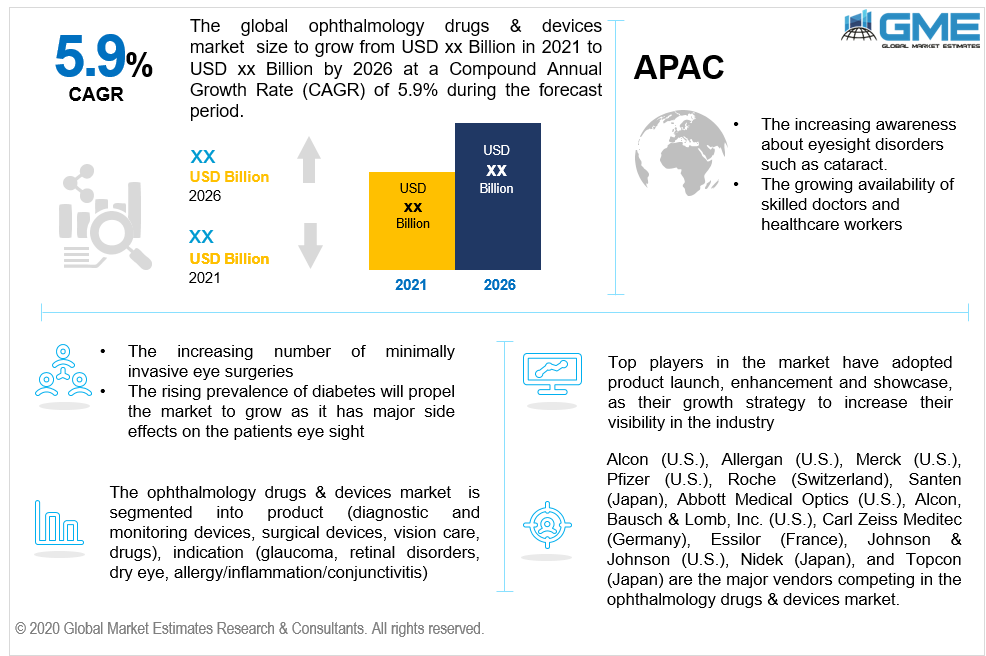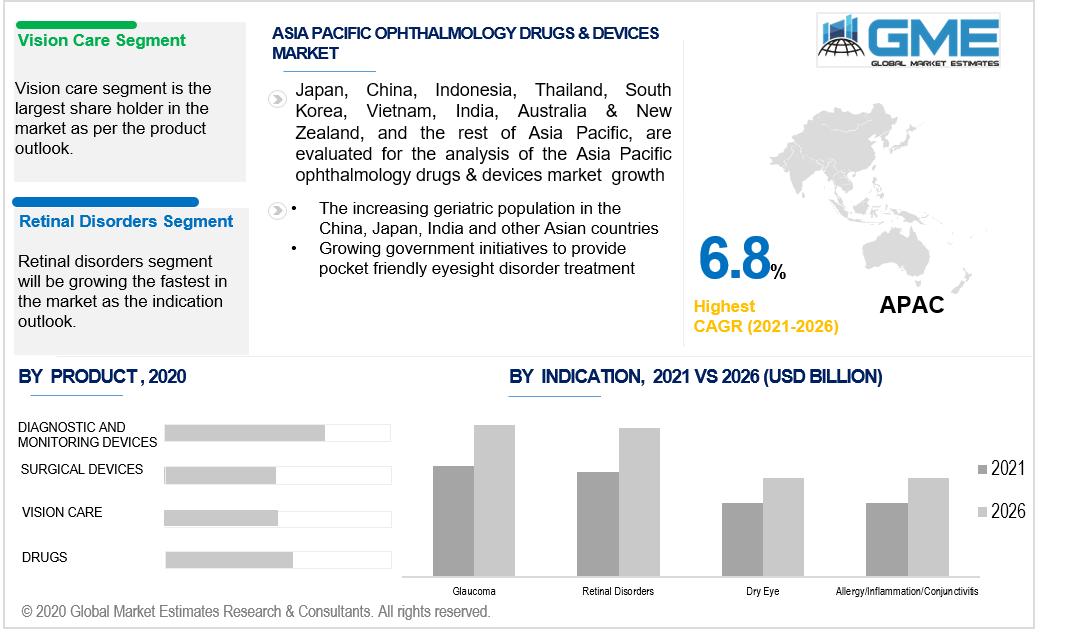
Global Ophthalmology Drugs & Devices Market Size, Trends, and Analysis- Forecasts To 2026 By Product (Diagnostic and Monitoring Devices [Optical Coherence Tomographers (OCT), Ophthalmic Ultrasound Imaging Systems, Fundus Cameras, Ophthalmoscopes, Retinoscopes, Wavefront Aberrometer, Corneal Topographer, Autorefractors/Phoropters, Pachymeters, Keratometers, Specular Microscopes, Biometers, Visual Field Analyzers/Perimeter, Tonometers, Slit Lamps, Optotype Projectors, Dioptometers], Surgical Devices [Cataract {Intraocular Lens (IOL), Ophthalmic Viscoelastic Devices (OVD), Phacoemulsification Devices}, Glaucoma {Glaucoma Drainage Devices (GDD), Stents and Implants, Glaucoma Lasers, Glaucoma Systems}, Refractive Error {Excimer Laser, YAG Laser, Microkeratome, Femtosecond Laser}, Vitreoretinal {Vitrectomy Machines, Photocoagulation Lasers, Illumination Devices}], Vision Care [Contact Lenses, Spectacles], Drugs [Existing Treatment Drugs, Drugs in Pipeline]), By Indication (Glaucoma, Retinal Disorders [Age-related Macular Degeneration (AMD), Diabetic Retinopathy, Macular Edema] Dry Eye, Allergy/Inflammation/Conjunctivitis), By Region (North America, Asia Pacific, CSA, Europe, and the Middle East and Africa); End-User Landscape, Company Market Share Analysis & Competitor Analysis
Ophthalmology is the study of the disorders affecting the human eye. As eyesight is a very important part of human life and its importance cannot be undermined, this industry is expected to grow rapidly in the forecast period. Since more than a decade, many countries are witnessing an increase in the number of eyesight disorders afflicting the population. This increase in eyesight-related problems is of major concern, ophthalmology drugs and devices are created to correct and treat the disorders that cause partial or complete vision impairment. Globally, the geriatric population has been increasing and various eye disorders like cataracts, presbyopia, macular degeneration, and diabetic retinopathy are caused by aging. Various other disorders are caused by the modern lifestyle and vices like smoking are known to cause an increase in the risk of eyesight disorders in later life. The growing prevalence of diabetes has increased the number of eyesight diseases among diabetic patients. Diabetes has been known to cause eye disorders like macular edema and retinopathy. Diabetes can cause the macular which is a vital part of the retina to swell which can cause complete or partial vision impairment and even complete blindness. The growing number of hours spent by an average person in front of a screen has increased in recent times which have contributed to vision impairments that require vision care devices like contact lenses and spectacle to correct their vision. These factors are some of the major drivers of the global ophthalmology drugs and devices market. The growing awareness of vision disorders has increased the demand and spending by the general population on ophthalmology devices and drugs globally. The increasing availability of ophthalmology drugs and devices to treat the various eye disorders afflicting the human eye has increased the genera; the population’s awareness of vision impairment has resulted in the growth of the ophthalmology drugs and devices market. There ophthalmology drugs and devices market has seen an increase due to the growing technological developments in the ophthalmology field which has resulted in novel devices and treatment techniques. Governments have begun to implement various initiatives and awareness drives to improve the awareness among the populace about the dangers and causes of vision impairment especially in later stages of life. The ophthalmology market is restrained by the high costs involved in the treatment of eyesight disorders and the cost of such devices. In developing nations, lack of health insurance coverage for ophthalmology is major restraints to the growth of the ophthalmology devices and drugs market.

Based on product, the ophthalmology drugs and devices market can be segmented into diagnostic and monitoring devices, surgical devices, vision care, and drugs as the main segments. The diagnostic and monitoring devices include optical coherence tomographers, ophthalmic ultrasound imaging systems, fundus cameras, ophthalmoscopes, retinoscopes, wavefront aberrometer, corneal topographer, autorefractors/phoropters, pachymeters, among other devices. Surgical devices are further segmented based on the disorders they treat like cataracts, glaucoma, refractive error, and vitreoretinal. The drugs segment includes drugs in the pipeline and existing treatment drugs. The vision care segment includes spectacles and contact lenses. The vision care segment will have the majority of the shares in the market in terms of revenue sales from 2021 to 2026. The growing number of vision impairment disorders like presbyopia in the older generations and myopia among the younger population due to the changing lifestyle of humans are expected to increase the demand for vision care products among all the other segments.
Based on the ophthalmology drugs available in the market, the ophthalmology drugs and devices market can be segmented into glaucoma, retinal disorder, dry eye, and allergy/inflammation/conjunctivitis. Retinal disorders include macular degeneration, diabetic retinopathy, and macular edema. The glaucoma segment will have the majority of the shares in the market in terms of revenue sales from 2021 to 2026. Glaucoma is a common eye disorder that generally afflicts the older population. The rise in aged population in the US and China is expected boost the demand for drugs that treat glaucoma.

As of 2020, the North American region holds the largest share in the entire market. North America is heavy spenders on healthcare and has highly sophisticated and advanced healthcare facilities that have facilitated the growth of the ophthalmology devices and rugs market in the region. The region has extensive healthcare insurance coverage and various government initiatives that have promoted people to avail eyesight disorder treatments like ophthalmology devices and drugs. The region also has a large geriatric population which has seen an increase in the number of eyesight disorders in the region. Along with a large geriatric population, the region also has a large number of diabetic patients which has also contributed to the high demand for ophthalmology drugs and devices in the region. The APAC region will grow faster than other regions with a high CAGR rate. The region has seen an increase in awareness among the population about eyesight disorders which are expected to increase the demand for ophthalmology devices and drugs in the region. The region has an increasing geriatric population which is expected to increase the prevalence of eyesight disorders like cataracts and glaucoma in the region which should cause an increase in the demand for ophthalmology devices and drugs in the region.
Topcon (Japan), Allergan (U.S.), Alcon (U.S.), Merck (U.S.), Roche (Switzerland), Pfizer (U.S.), Santen (Japan), Bausch & Lomb, Inc. (U.S.), Abbott Medical Optics (U.S.), Carl Zeiss Meditec (Germany), Johnson & Johnson (U.S.), ), Essilor (France), and Nidek (Japan), among others, are the major vendors competing in the ophthalmology drugs & devices market.
Please note: This is not an exhaustive list of companies profiled in the report.
We value your investment and offer free customization with every report to fulfil your exact research needs.
The Global Ophthalmology Drugs & Devices Market has been studied from the year 2019 till 2026. However, the CAGR provided in the report is from the year 2021 to 2026. The research methodology involved three stages: Desk research, Primary research, and Analysis & Output from the entire research process.

The desk research involved a robust background study which meant referring to paid and unpaid databases to understand the market dynamics; mapping contracts from press releases; identifying the key players in the market, studying their product portfolio, competition level, annual reports/SEC filings & investor presentations; and learning the demand and supply-side analysis for the Ophthalmology Drugs & Devices Market.

The primary research activity included telephonic conversations with more than 50 tier 1 industry consultants, distributors, and end-use product manufacturers.

Finally, based on the above thorough research process, an in-depth analysis was carried out considering the following aspects: market attractiveness, current & future market trends, market share analysis, SWOT analysis of the company and customer analytics.

Tailor made solutions just for you
80% of our clients seek made-to-order reports. How do you want us to tailor yours?
OUR CLIENTS